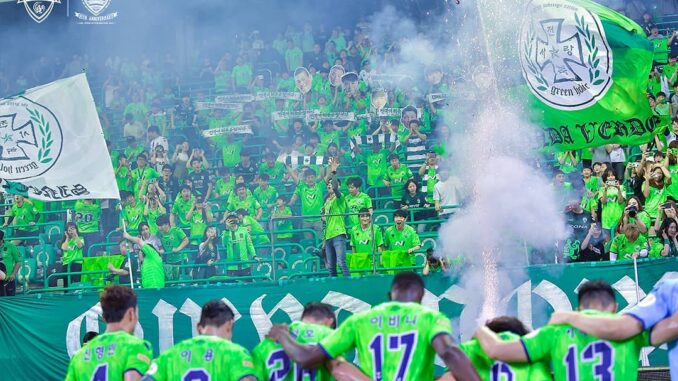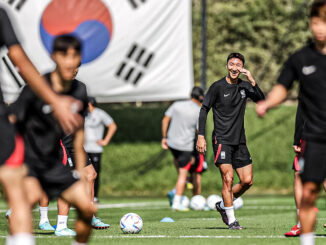
With the K League set the resume this weekend, not since 2002, when South Korea co-hosted Asia’s first FIFA World Cup (of the men’s variety) with Japan, has Korean football garnered such international attention.
The Taeguk Warriors’ improbable run to the semi finals enraptured an entire nation, with tens of millions pouring into stadiums and onto the streets of cities across the country – all clad in red – to cheer on their new heroes.
This was meant to be the catalyst for a new era in Korean football, with an increasing number of players heading for the bright lights of Europe – headlined by Park Ji-sung – while the K League, founded in 1983, making it Asia’s oldest professional league, was expected to boom as the popularity of football reached fever pitch.
“CU@K-League” read a banner as Korea reached the final four in 2002. And for a period of time, they did. In relatively large numbers. But the novelty and shine gradually wore off, and increasingly crowds started dropping, reaching its nadir in 2018 when average attendance plummeted to an all-time low of just 5381. Playing in over-sized, atmosphere-destroying stadiums didn’t help.
By way of comparison, East Asia’s two other big leagues – the J.League and Chinese Super League – averaged 19,064 and 24,053 respectively in 2018.
Korean football, domestically, was gravely ill. How did it come to this for Asia’s most successful country, with more World Cup appearances than any other and more AFC Champions League winners than any other?
For all that continental success, however, the K League has always been in the shadow of the J.League, and even in recent years the Chinese Super League, never managing to step out from that shadow to stake a legitimate claim as Asia’s premier domestic competition.
The J.League has bigger crowds – far bigger crowds, in fact – which only adds to the aesthetics and spectacle of each match. Last season’s lowest average attendance in the J.League was Shonan Bellmare with 12,848 – a figure that would have been enough to put them third in the K League, behind only FC Seoul (17,061) and Jeonbuk Hyundai (13,937).
J.League fans are renowned the continent over for their colour and noise. The K League, on the other hand, is often played against a backdrop of empty, cavernous stadiums.
Whereas the J.League insisted on clubs immersing themselves in the community and ridding themselves of their corporate names, the K League never went down that path, at least not to the same degree, and to this day clubs continue to exist with their corporate monikers – think Jeonbuk Hyundai Motors, Ulsan Hyundai and Suwon Samsung Bluewings.
Whether that has hindered the development of the league, and the attachment those communities feel to those clubs, is open to debate. Some will argue it has, some will argue it hasn’t.
But should the K League’s most successful club, who has won five of the last six titles, be averaging more than 13,000? The answer is quite clearly, yes.
With little TV revenue to keep clubs afloat, clubs were solely reliant on their corporate owners, ‘chaebol’ as they are known in Korea, or local governments for the so-called ‘citizen clubs’, and when purse strings were tightened at the top, the football clubs suffered. Just ask fans of Suwon, once one of the continent’s superpowers but who have struggled in recent years as budget cuts hit hard.
Their last title came back in 2008 (when they averaged a crowd of over 23,000; last year it dropped to just under 9000), while last year they finished 31 points behind champions, Jeonbuk. Remarkably, that was better than 2018 when they finished 36 points behind the champions.
The Bluewings have had their wings clipped.
Despite the obvious doom and gloom, however, in the last 12 months there are signs of life emerging. More and more clubs are opting to move out of their cavernous, soulless World Cup stadiums, opting for more boutique venues.
Daegu FC were one of the first to make the leap, and last season it paid off handsomely. In 2018, their last season at the Daegu World Cup Stadium, they averaged just over 3,000, with only 66,000 in total attending across the season.
Moving to the more compact, boutique Daegu Bank Park in 2019, attendances spiked, increasing by a staggering 205%. The 12,000-capacity stadium was filled more often than not, with an average of 10,734 across the season.
This is the blueprint for the future, and pleasingly, other clubs are starting to follow suit. It helped the league last year record an average of 8014, its biggest average attendance since 2011.
That brings us to this season, which begins on Friday night when defending champions Jeonbuk play host to FA Cup winners, Suwon Bluewings.
While there’s no chance of attendance records being smashed this year, with games to be played behind closed doors for the immediate future, it is by far the highest profile league anywhere in the world to resume playing.
While domestic TV rights have been a hard sell in recent years, the paucity of live football around the world has seen broadcasters from across the globe, from Croatia to Malaysia, sign deals to broadcast the K League. Now, the whole world will be watching.
Thanks to the exploits of Park, and more recently Son Heung-min, not to mention the dozens of others across Europe, Korean football has a strong reputation around the world. Scouts have often cast their eye over the league, looking for the next young sensation to take to Europe, and the K League has given them plenty.
It remains one of the toughest leagues in Asia, just ask anyone who has played there, and an incredible breeding ground for talent.
Given they co-hosted 2002, comparisons with Japan and the divergent paths their domestic leagues have taken since then are hard to avoid. But with the J.League still sidelined by the COVID-19 pandemic, this is the K League’s time to shine.
Photo: Facebook/Jeonbuk Hyundai Motors




